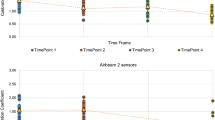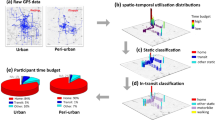Abstract
Study question: We examined whether methods for measuring exposure to airborne particles less than 10 μm in aerodynamic diameter (PM10) in the Mexico City metropolitan area give different estimates of PM10 levels, and the nature of these differences, and developed a model for estimating missing PM10 data for one measurement method. Methods: Government PM10 measurements using two different technologies at five sites (the Sierra–Anderson PM10 High-Volume Air Sampler System, Hi-Vol) (every sixth day) and the Rupprecht and Patashnik Tapered Element Oscillating Microbalance (TEOM) monitor (daily), as well as Harvard Impactor (HI) data collected for research purposes from one monitoring station were matched by day and monitoring site, then compared visually and with basic descriptive statistics. We fit linear regression models with airport visual range measurements, meteorological data, and information on other air pollutants to predict the Hi-Vol measured PM10 levels for those days when direct measurements were not available. Results: We found relatively low correlations (r ranging from 0.46 to 0.63) between PM10 measured with the TEOM and Hi-Vol methods, and highly variable differences (0–70 μg/m3) between the means of these measurements, depending on monitoring site. The HI measurements had a relatively high correlation with the Hi-Vol measurements (r=0.90). The models developed for the missing Hi-Vol measurements provided a series of estimated values similar to the actual Hi-Vol measurements, although the estimated series did not have high values in the range observed in the measured data. Conclusions: The differences we observed in the PM10 measurements across methods in Mexico City may be important when studying health effects associated with particle exposure, evaluating method performance under conditions and operating protocols similar to those in Mexico City, and determining compliance with air quality standards. The estimated series of PM10 measures may be a useful index of exposure for use in studies of the effects of air pollution on health.
This is a preview of subscription content, access via your institution
Access options
Subscribe to this journal
Receive 6 print issues and online access
$259.00 per year
only $43.17 per issue
Buy this article
- Purchase on Springer Link
- Instant access to full article PDF
Prices may be subject to local taxes which are calculated during checkout





Similar content being viewed by others
Abbreviations
- μg/m3:
-
micrograms per cubic meter
- B ext :
-
extinction coefficient (total amount of light attenuated through absorption and scattering by particles and gases)
- GDF:
-
Gobierno del Distrito Federal (Government of the Federal District)
- HI:
-
Harvard Impactor low-flow size-fractionated particle sampler
- Hi-Vol:
-
Graseby–Anderson GMW Model 1200 High-Volume Air Sampler System
- IMP:
-
Instituto Mexicano del Petróleo (Mexican Petroleum Institute)
- NO2:
-
nitrogen dioxide
- O3:
-
ozone
- PM10:
-
airborne particles less than 10 μm in aerodynamic diameter
- PM2.5:
-
airborne particles less than 2.5 μm in aerodynamic diameter
- ppb:
-
parts per billion
- TEOM:
-
Rupprecht and Patashnik Tapered Element Oscillating Microbalance
- TSP:
-
total suspended particle
References
Abbey DE Ostro BE Fraser G Vancuren T Burchette RJ Estimating fine particulates less than 2.5 microns in aerodynamic diameter (PM2.5) from airport visibility data in California, J Expos Anal Environ Epidemiol (1995) 5: 161–180
Aguilar AG Ezcurra E García T Hiriart MM Pisanty I The basin of Mexico In: Kasperson J.X., Kasperson R.E., and Turner B.L.I. (Eds.) Regions at Risk: Comparisons of Threatened Environments. United Nations University Press, Tokyo 1995
Allen G Sioutas C Koutrakis P Reiss R Lurmann FW Roberts PT Evaluation of the TEOM method for measurement of ambient particulate mass in urban areas, J Air Waste Manage Assoc (1997) 47: 682–689
Anderson HR Ponce De Leon A Bland JM Bower JS Strachan DP Air pollution and daily mortality in London: 1987–92, Br Med J (1996) 312: 665–669
AP. Mexican state governments reject daylight-saving time, News Obs (April 3, 1998) http://www.newsobserver.com/newsroom/ntn/world/040398/world2_17483_noframes.html
Bobak M Leon DA Air pollution and infant mortality in the Czech Republic, 1986–88, Lancet (1992) 340: 1010–1014
Bravo H Torres R Saavedra M Aguilar S Correlation between TSP, FSP and visibility in a high altitude city (Mexico City), Sci Total Environ (1982) 24: 177–182
Bravo H Saavedra M Torres R Lomas G Nava D Tirado D Particulate carbon, a significant contributor to the visibility reduction of Mexico City, Geofís Int: Rev Unión Geofís Mex (1988) 27: 241–261
Chow JC Measurement methods to determine compliance with ambient air quality standards for suspended particles, J Air Waste Manage Assoc (1995) 45: 320–382
Cyrys J Poster: PM2.5 measurements in ambient aerosol: TEOM vs. Harvard Impactor. Presented at International Society for Environmental Epidemiology conference, Buffalo, NY (2000
DDF Programa para mejorar la calidad del aire en el Valle de México (Program to Improve Air Quality in the Valley of Mexico). Departamento del Distrito Federal (DDF), Gobierno del Estado de México, Secretaría de Medio Ambiente, Recursos Naturales y Pesca, Secretaría de Salud, Mexico City 1996
Delfino RJ Becklake MR Hanley JA Singh B Estimation of unmeasured particulate air pollution data for an epidemiological study of daily respiratory morbidity, Environ Res (1994) 67: 20–38
Dockery DW Pope CA 3rd Acute respiratory effects of particulate air pollution, Annu Rev Public Health (1994) 15: 107–132
Edgerton S Bian X Doran J Fast J Hubbe J Malone E Shaw W Whiteman C Zhong S Arriaga J Ortiz E Ruiz M Sosa G Vega E Limon T Guzman F Archuleta J Bossert J Elliot S Lee J Mcnair L Chow J Watson J Coulter R Doskey P Gaffney J Marley N Neff W Petty R Particulate air pollution in Mexico City: a collaborative research project, J Air Waste Manage Assoc (1999) 49: 1221–1229
Hinds W Aerosol Technology: Properties, Behavior and Measurement of Airborne Particles. Wiley, NY 1982
Hoek G Schwartz JD Groot B Eilers P Effects of ambient particulate matter and ozone on daily mortality in Rotterdam, The Netherlands, Arch Environ Health (1997) 52: 455–463
Ito K Thurston GD Characterization and reconstruction of historical London, England, acidic aerosol concentrations, Environ Health Perspect (1989) 79: 35–42
Janssen NA Hoek G Harssema H Brunekreef B Personal exposure to fine particles in children correlates closely with ambient fine particles, Arch Environ Health (1999) 54: 95–101
Kinney PL Ozkaynak H Associations of daily mortality and air pollution in Los Angeles County, Environ Res (1991) 54: 99–120
Kleinbaum DG Kupper LL Muller KE Applied Regression Analysis and Other Multi-Variable Methods. Duxbury Press, Belmont CA 1988 p 718
Knobel HH Chen CJ Liang KY Sudden infant death syndrome in relation to weather and optimetrically measured air pollution in Taiwan, Pediatrics (1995) 96: 1106–1110
Levy JI Hammitt JK Spengler JD Estimating mortality impacts of particulate matter: what can be learned from between-study variability?, Environ Health Perspect (2000) 108: 109–117
Loomis D Castillejos M Gold DR Mcdonnell W Borja-Aburto VH Air pollution and infant mortality in Mexico City, Epidemiology (1999) 10: 118–123
McMichael AJ Anderson HR Brunekreef B Cohen AJ Inappropriate use of daily mortality analyses to estimate longer-term mortality effects of air pollution, Int J Epidemiol (1998) 27: 450–453
México CAM La contaminación atmosférica en el Valle de México: Acciones para su control, 1988–1994. Comisión Metropolitana Para la Prevención y Control de la Contaminación Ambiental en el Valle de México, Mexico City 1995 pp 34–39
Michaels RA Kleinman MT Incidence and apparent health significance of brief airborne particle excursions, Aerosol Sci Technol (2000) 32: 93–105
Moolgavkar SH Luebeck EG A critical review of the evidence on particulate air pollution and mortality, Epidemiology (1996) 7: 420–428
Mora Perdomo VR Melgar Paniagua EM Pascual Gómez C San Miguel Castillo JJ Yañez Rodríguez G Quintanar Isaias A Castillo González H Análisis histórico de la visibilidad en el Aeropuerto Internacional Benito Juárez y Tacubaya de la Ciudad de México e impacto de la contaminación atmosférica en el deterioro de la visibilidad. Instituto Mexicano del Petroleo, Mexico City 1999
NOAA Federal Meteorological Handbook No. 1: Surface Weather Observations and Reports (FMH-1). National Oceanic and Atmospheric Administration, Washington, DC 1995
Ostro B The association of air pollution and mortality: examining the case for inference, Arch Environ Health (1993) 48: 336–342
Ostro B Fine particulate air pollution and mortality in two Southern California counties, Environ Res (1995) 70: 98–104
Ozkaynak H Schatz AD Thurston GD Relationships between aerosol extinction coefficients derived from airport visual range observations and alternative measures of airborne particle mass, J Air Pollut Control Assoc (1985) 35: 1176–1185
Patashnick H Rupprecht EG Continuous PM-10 measurements using the Tapered Element Oscillating Microbalance, J Air Waste Manage Assoc (1991) 41: 1079–1083
Pope CA Schwartz J Ransom MR Daily mortality and PM10 pollution in Utah Valley, Arch Environ Health (1992) 47: 211–217
Richards LW Dye TS Arthur M Byars MS Analysis of ASOS Data for Visibility Purposes. Sonoma Technology, Santa Rosa, CA 1996
Saldiva PHN Lichtenfels AJ.FC Paiva PSO Barone IA Martins MA Massad E Pereira JCR Xavier VP Singer JM Bohm GM Association between air pollution and mortality due to respiratory diseases in children in Sao Paulo, Brazil: a preliminary report, Environ Res (1994) 65: 218–225
Schwartz J Particulate air pollution and daily mortality in Detroit, Environ Res (1991) 56: 204–213
Shaddick G Wakefield J Elliott P Modelling levels of pollution for use in time series studies examining the relationship between air pollution and health, Epidemiology (2000) 11: S103
Simpson RW Williams G Petroeschevsky A Morgan G Rutherford S Associations between outdoor air pollution and daily mortality in Brisbane, Australia, Arch Environ Health (1997) 52: 442–454
Thurston GD A critical review of PM10-mortality time-series studies, J Expos Anal Environ Epidemiol (1996) 6: 3–21
Vajanapoom N Particulate air pollution and daily mortality in Bangkok Doctoral dissertationUniversity of North Carolina at Chapel Hill 1999
Acknowledgements
We thank Enrique Camarillo Cruz, Margarita Castillejos Salazar, Jorge Martínez Castillejos, Roberto Muñoz Cruz, and Victor Borja Aburto for data access; the staff of the Centro Nacional de Salud Ambiental, Jean Keller, and Lawrence Park for help with programming and data management; and Evan Hammer and Pablo Cicero Fernández for assistance with the map. We thank Irva Hertz Picciotto, Carl Shy, and Steve Wing for comments on the manuscript. Marie O'Neill received financial support for this research from the Mellon Foundation, the Institute of Latin American Studies at the University of North Carolina-Chapel Hill, a Fulbright-Garcia Robles grant, and the William R. Kenan, Jr. Fellowship. Institutional support in Mexico was provided by the Centro Nacional de Salud Ambiental (Victor Borja Aburto, sponsor) and the Colegio de México (José Luis Lezama, sponsor). Part of this work was completed while Marie O'Neill was employed at the Instituto Nacional de Salud Pública, Cuernavaca, México.
This study was supported, in part, by Cooperative Agreements CR816071 and CR821762 from the US EPA National Health and Ecological Effects Research Laboratory and by the Universidad Autonoma Metropolitana-Xochimilco (UAM-X). Although the research described in this article was funded by the US EPA and UAM-X, it has not been subjected to Agency review and therefore does not necessarily reflect the views of the Agency; no official endorsement should be inferred. Mention of trade names or commercial products does not constitute endorsement or recommendation for use.
Author information
Authors and Affiliations
Corresponding author
Rights and permissions
About this article
Cite this article
O'NEILL, M., LOOMIS, D., TORRES MEZA, V. et al. Estimating particle exposure in the Mexico City metropolitan area. J Expo Sci Environ Epidemiol 12, 145–156 (2002). https://doi.org/10.1038/sj.jea.7500212
Received:
Published:
Issue Date:
DOI: https://doi.org/10.1038/sj.jea.7500212
Keywords
This article is cited by
-
The pregnancy research on inflammation, nutrition, & city environment: systematic analyses study (PRINCESA) cohort, 2009–2015
European Journal of Epidemiology (2023)
-
Do associations between airborne particles and daily mortality in Mexico City differ by measurement method, region, or modeling strategy?
Journal of Exposure Science & Environmental Epidemiology (2004)



